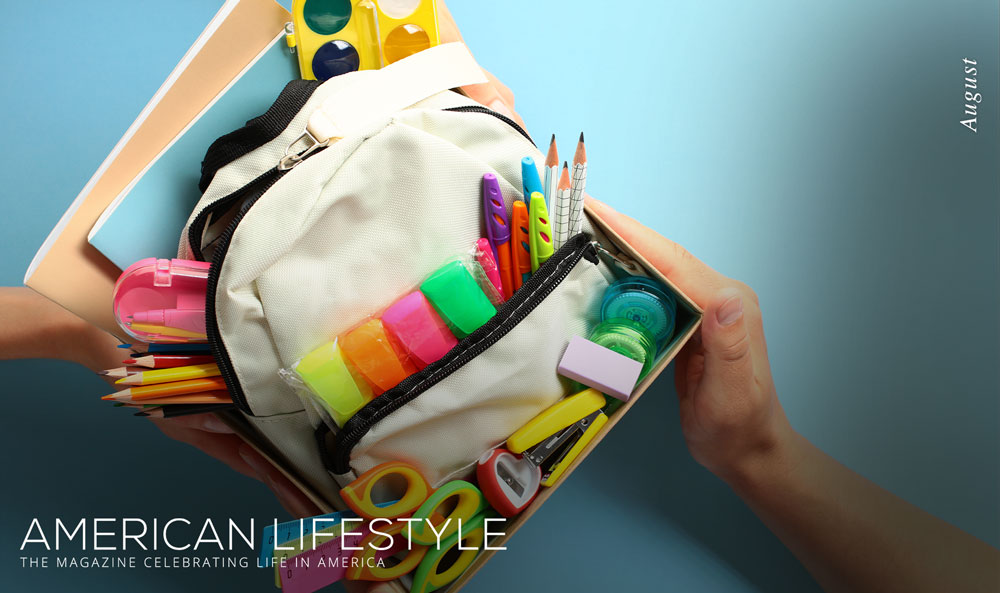Summer may soon be winding down, but that doesn't mean the time for adventures is over. To help you stay inspired and make the most of the remainder of the season, this issue of American Lifestyle is here with new destinations to explore in the western United States, fresh handheld meals, a deep dive into an artist's incredible journey, and a look at how one Ohio charity assists teachers and students in need.
If you're seeking new spots for your travels, why not consider some of our nation’s most stunning yet lesser-known destinations? To the west, you'll find spectacular natural locales that offer seemingly otherworldly landscapes, including the icy ridges of the Tracy Arm Fjord in Alaska and the cracked desert floor of Badwater Basin in California—see the enclosed guide for more.
Nothing can lend a pick-me-up like fresh and vibrant flavors, and the two included Mediterranean-inspired sandwich recipes provide them in spades. Whether for lunch or dinner, enjoy a chicken gyro stuffed with crisp veggies and cool tzatziki or an Egyptian falafel wrap featuring tangy pickles and a creamy tahini sauce. Either is sure to satisfy!
The path to art success isn't always simple or straightforward, as the painter Cooper can certainly attest to. Discover how this Indiana native went from creating murals on buildings to showcasing his imaginative paintings at prestigious fine art galleries, proving that with dedication and determination, anything is possible.
Every child deserves the materials they need to thrive in school, and the nonprofit Crayons to Classrooms endeavors to help teachers supply such materials at no cost to them. Inside, marketing coordinator Malena Ball shares the difference that committed volunteers and hard work can make in supporting education.
Here’s to the many opportunities this month holds! As always, it's a pleasure to send you this magazine.
Our nation’s Western region boasts a spectacular array of vistas, from icy-blue glaciers that glitter in the sun to ethereal deserts that extend as far as the eye can see. Some of its most breathtaking spots have even gained worldwide fame, including the Grand Canyon and Yellowstone National Park.
But there’s more out there to take in than these typical landmarks. If you’re looking to fill your photo album with more extraordinary sights, seek out a few less conventional selections: quirky and downright strange scenes dotted across the varied patchwork of US geology. Here are four oddities where you’ll find Mother Nature’s creativity on full display—and be inspired to see what else the American West has to offer.
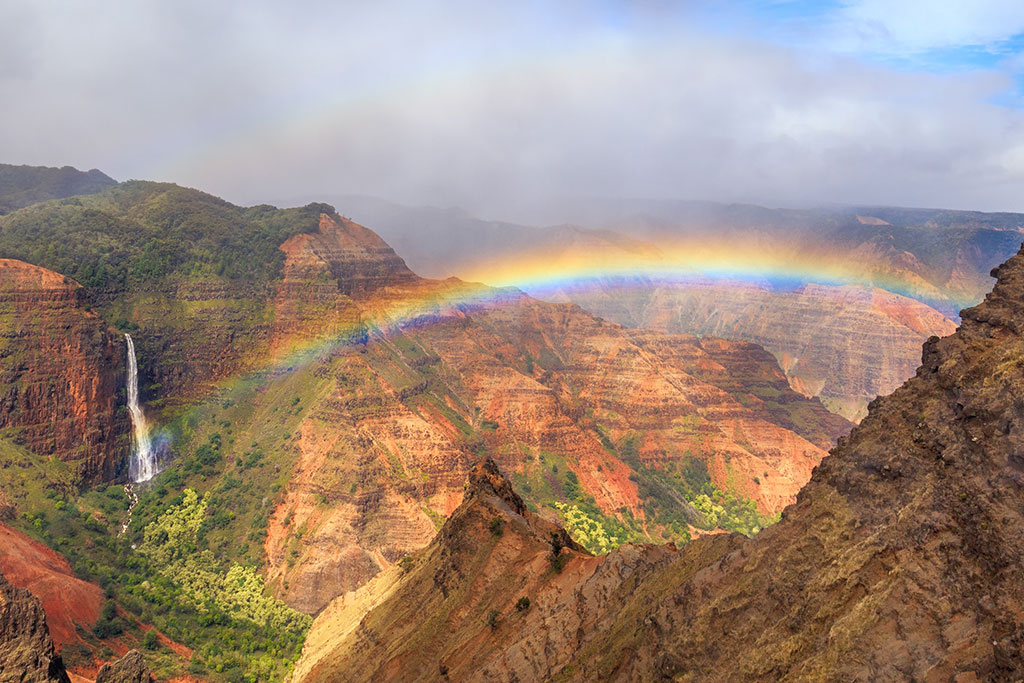
With all this lush state’s awe-inspiring qualities, from jewel-toned waves to vibrant palm beaches, some of its more obscure sites may go unnoticed. Take “the Grand Canyon of the Pacific,” located on the island of Kauai. Here, a more than 3,000-foot-deep chasm surrounded by tropical trees conceals the mystifying Waimea River, which flows red through the over ten-mile-long canyon amid rugged crags and rushing waterfalls.
As grisly as it may sound, though, the river actually gets its color from the vibrant sediment of the surrounding walls, which is deposited by erosion. If you’re active and healthy, admire the waters up close via a jagged hike down Kukui Trail to the canyon floor. Or stick to the Iliau Nature Loop Trail at the top of the ridge for panoramic views of the rock formations and tropical forest—you may even see a rainbow crossing the expanse for an additional splash of enchanting color.
Another option is to take a car ride up Waimea Canyon Drive onto Kokee Road, a route that snakes through Waimea Canyon State Park along the west side of the expanse and features abundant scenic viewpoints. And don’t leave without trekking to Waipoo Falls, an 800-foot spectacle that pours into the rosy canyon below. Just be sure to bring an umbrella since this is considered one of the rainiest places on earth.

Like Hawaii, our northernmost state is absolutely brimming with marvels, but this glacial setting may be one of its lesser-known quirks of creation. Technically a fjord, or narrow inlet of water between tall cliffs, Tracy Arm is notable for its 1,000-foot waterfalls and perennially snow-capped mountains—in fact, this remote region can see more than one hundred feet of snow annually!
Perhaps the most astounding tourist draws, however, are the ice formations, including the Sawyer Glaciers: tremendous forms that extend from deep underwater, giving them an extraordinary sapphire-blue color. They are also ever-changing; visitors often describe hearing an echoing crash as they witness giant ice mounds tumbling into the waters below, which then flow downstream among a litter of other enormous ice shards.
You can locate Tracy Arm Fjord just forty-five miles south of the state’s capital, Juneau. This unforgiving landscape is only accessible by boat or plane, making it virtually necessary to book a guided tour. But it’s well worth the investment to access what naturalist John Muir once referred to as “a wild, unfinished Yosemite.”
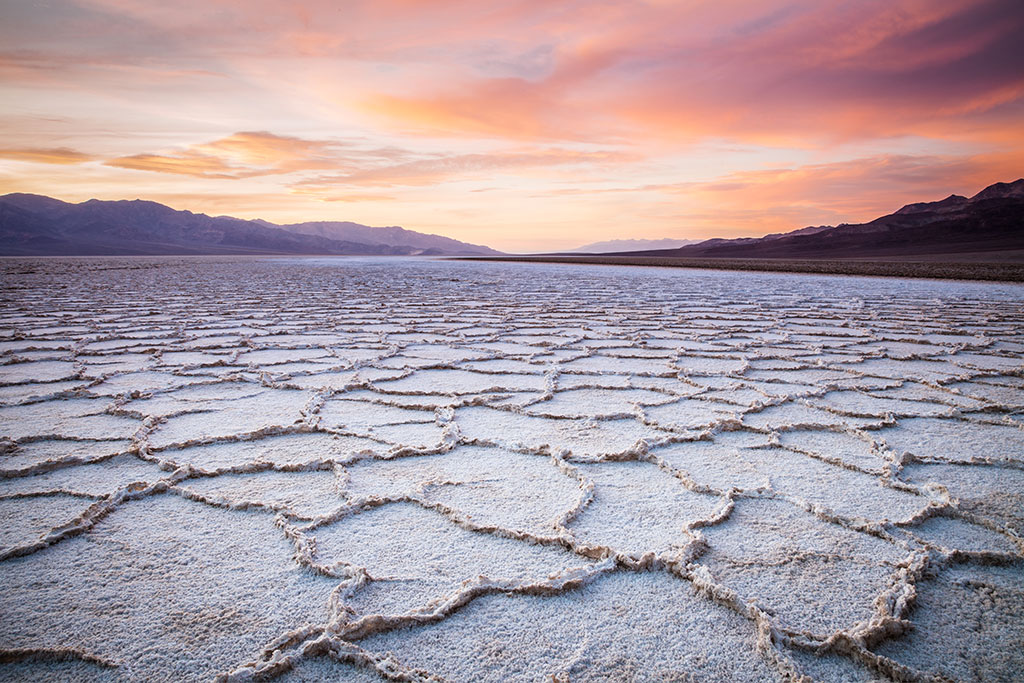
At 282 feet below sea level, this California peculiarity earns the designation of the lowest point on the continent. The stark-white expanse within Death Valley National Park is actually the remains of an ancient lake that dried up to reveal salt flats, or grounds rich in minerals like sodium chloride (the chemical we know as table salt), which have formed into crystalized, cracked slabs that rise from the sandy floor and sparkle in the sun. As for the former lake’s disappearance, blame it on Badwater Basin’s extreme evaporation rate of 150 inches annually, meaning that a twelve-foot-deep, thirty-mile-long lake would dry up in just one year.
Oddly enough, though, some wildlife in the area, including unique plants and snails, has evolved to tolerate the high salinity and heat of this landscape. Unfortunately, the same can’t be said for humans, so if you’re planning a visit here, book an offseason trip in late fall or winter and take an early morning excursion. You can view the strange scene from the comfort of your car or along the Badwater Basin Salt Flats Trail, featuring a convenient boardwalk as well as a quick, immersive hike across the lake’s remains. No matter which path you choose, visiting this desert is an experience you surely won’t forget.
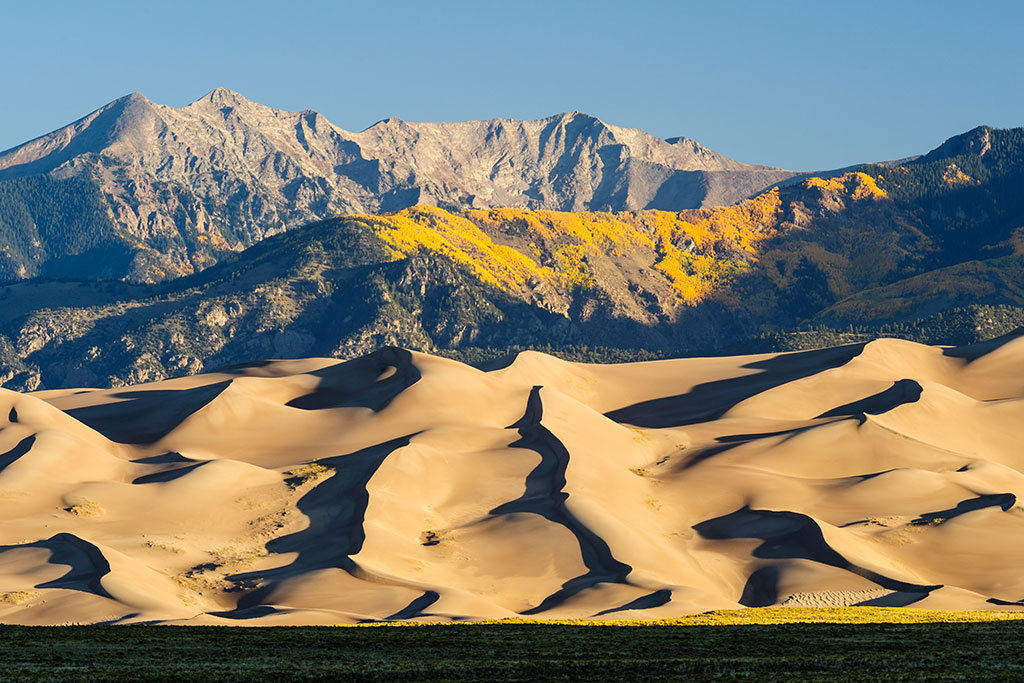
High in the Rocky Mountain range sit some of America’s loftier peaks—and, strangely, its tallest sand dunes. That’s right, our greatest sandy pinnacles are flanked by snowy mountains in rugged Colorado, reaching heights up to 741 feet. But how did Mother Nature build a desert here? Ironically, the answer is not a lack of moisture but a direct consequence of it. As nearby rivers and creeks carried sediment and sand downstream, the deposits settled in this deep, bowl-like valley. Storm winds from the surrounding summits then eventually shaped the Great Sand Dunes we see today. These weather conditions make this miniature desert shift and change all the time, so each visitor is guaranteed a unique experience.
Surprisingly, there are no trails across the thirty-square-mile dune field, allowing you to wander the area at your leisure. You might even spot some visitors “sandboarding” across the waves—or grab a sled and give it a go yourself! And if you’re looking to get your heart pumping, you can hike up any of the many dunes for spectacular views from the top (an arduous yet satisfying hours-long trek) or along a shaded forest trail to escape the sun. Whatever your adventure of choice, make sure to stay after dark on a clear night for unbelievable stargazing as spectacular as the terrestrial scene at your feet.
In many ways, a sandwich is an ideal lunch solution—it’s simple and easy to make, beckons fresh ingredients, and fits perfectly in your hands. That’s why it’s been a menu staple for centuries, not only in the States but also abroad. These recipes from The Sandwich Shop offer a Mediterranean flair to this classic meal, making it even more mouthwatering.
This amazing concoction is chock-full of fresh veggies, marinated poultry, and cool, tangy tzatziki, all packed into a fluffy pita.
Expected the unexpected with this flatbread wrap, which includes pickles, turnips, chilies, and a zesty tahini sauce.
Recipes excerpted from The Sandwich Shop: 50 Great Sandwich Recipes by Lucy Heaver and Aisling Coughlan. Smith Street Gift, 2023. Photography © Chris Middleton
recipe by lucy heaver and aisling coughlan
photos by chris middleton
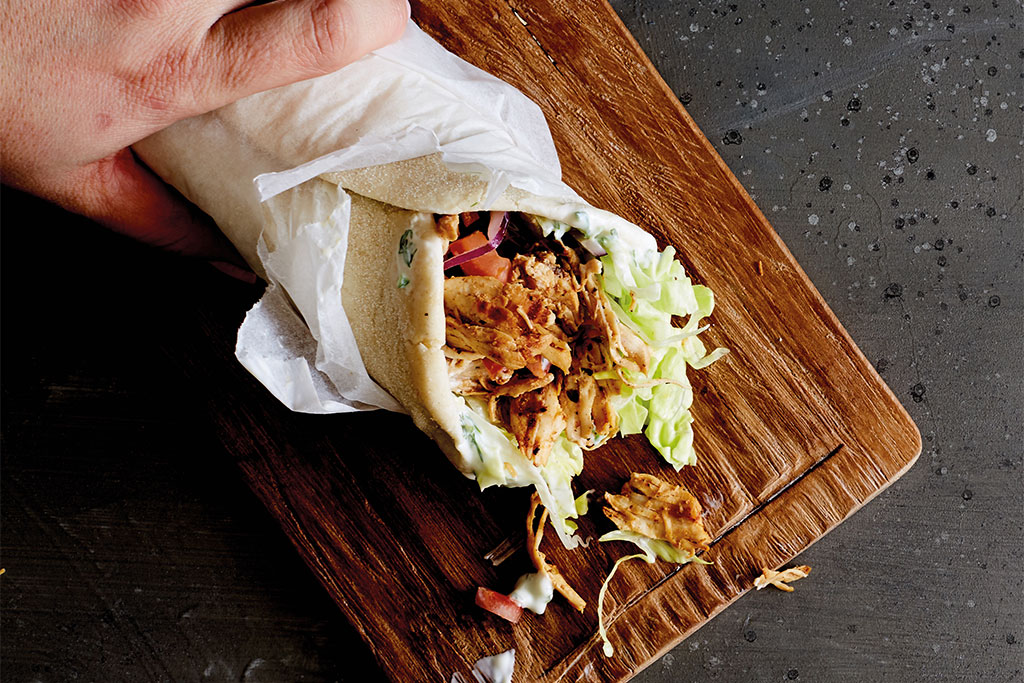
Serves 2


recipe by lucy heaver and aisling coughlan
photos by chris middleton

Serves 2


Contemporary painter Andrew Cooper, known professionally by his last name, paints vibrant and inviting scenes that evoke blissful spaces and idyllic moments, often stemming from his own happy childhood memories. Here he describes his journey from eking out a living as a young muralist to having his works consistently sell out in prestigious art galleries in both New York City and London.

Did you always want to be an artist?
I liked art growing up in Indiana—my mom has a few of my sketchbooks from when I was between five and seven years old. But because I was active in sports, I didn’t pursue it for a while. I even took business classes my first year at Ball State University in Muncie, Indiana. I then enrolled in a sculpture class, and an instructor noticed my drawings the very first week of the semester. She immediately helped me change my schedule and enter the art program, where I began majoring in graphic arts.
Following graduation, I moved to Miami and worked at a record label drawing album covers and creating posters. In my spare time, I searched Craigslist for local companies and buildings that had blank walls I could cover with murals. While I didn’t get paid for that work and had to buy my own supplies, it allowed me to develop my style. I also took photos of my murals, sharing them on Instagram to help develop my brand as an artist.
How did painting murals evolve into a career?
After about a year, I relocated to Los Angeles in 2018 with my three best friends. There, I continued working on murals and putting the results on Instagram. That helped me get noticed by PUMA later that year, who said they loved what I was doing and asked me to paint a basketball court for famous rapper Nipsey Hussle’s former high school in LA.
Following that, I was the branding artist partnered with Mountain Dew for the 2019 Dew Tour in Long Branch, California, which was televised nationally and featured some of the biggest skateboarders in the world. My art was on all the merchandise and the bowl they skated in—it was a really cool experience. The luxury brand Coach also asked me to collaborate with them around this time. So much happened because of the murals.

Why did you switch from murals to paintings?
A few years into creating murals, I realized that while the medium was fun, I was ready to focus on painting canvases. I knew long term that I wanted to be in galleries all around the world and figured this next step in my career might take a while to develop. I decided to return to Indiana since I would have fewer distractions and more time to develop my new artistic style on canvas. So in 2020, I moved back to Evansville, where I could have a city lifestyle but still live somewhere quiet and away from city noise to help me focus. I then began collaborating with a local gallery and building my Instagram page as my portfolio to showcase new paintings.
Before long, Manhattan’s Guy Hepner gallery offered me a show, which we launched in 2021 (online only due to the COVID-19 pandemic). I exhibited six large canvases that sold the very first day. London’s Maddox Gallery then saw my work and immediately bought me a plane ticket to come meet them overseas. My first show with them was in 2022, and we’ve been working together ever since. I now paint in my Evansville studio, a 1913 fire station that I purchased last summer. My wife, Tabitha Taylor Cooper, also has her own painting space in it. We live upstairs and work downstairs.

How do you approach your paintings?
My works are like collages; I might include an image from my memory or one from a magazine. For example, my very first idea for a painting was a stereo my grandparents had when I was a kid. During the holidays, my grandpa would put records on it, which he kept in the basement. I loved playing with my cousins while listening to Christmas music. I took that memory, modernized the stereo, and added everyday still lifes, as I call them, around it.
Ultimately, I paint what means the most to me. I enjoy taking common objects and making them look beautiful. We go through life so quickly—sometimes we don’t acknowledge the small things that bring the most joy. One painting also often leads to the next. Whenever I begin something new, I might look at the most recent work I completed, borrowing some details and then changing the rest up a bit, such as by updating the primary object and perhaps adding a new color, design, or background.

How has your process changed over the years?
When I was creating murals, I did so with exterior house paint like Sherwin-Williams. I now use Golden brand acrylics and linen canvases, which range from small ones of 20 by 24 inches to much bigger ones of several feet. It’s fun working on the larger paintings because I can become immersed in them, letting them take over my senses. It’s a beautiful feeling.
What advice do you have for other aspiring artists?
If you’re passionate about it, go for it—the universe will eventually reward you for your efforts. In fact, your next opportunity could be around the corner. I kept pushing forward, listening to my heart and creating what I wanted. Today, my wife and I are both full-time artists and my work has even been shown in the Torrance Art Museum in Southern California. We share a home and our dogs and are doing well; we are so lucky to be where we are now.
For more info, visit cooperart.me or follow Cooper on Instagram @iam.cooper
Malena Ball, marketing coordinator for the Ohio-based nonprofit Crayons to Classrooms, shares how the organization is supporting teachers and students in Miami Valley.
Tell us about your company’s mission:
About 70 percent of students in our area don’t have basic necessities, so teachers will spend their own money to get those items for them. We work to bridge that gap by securing and distributing school supplies at no cost to teachers, ensuring that every student has the tools they need to succeed inside the classroom. We believe that no teacher should have to take on such a financial burden and that no student should have to struggle due to a lack of supplies.

How do teachers get these supplies?
Right now, we work with 143 schools in the region, including childcare centers and pre-K to twelfth grade. Teachers from schools where 60 percent or more of the students participate in the National School Lunch Program can come to our store in Dayton once a semester and collect classroom materials. It’s stocked with a wide range of supplies, from everyday essentials like notebooks to larger necessities like backpacks; we also provide cleaning products, bulletin board decorations, and books. Everything is new and organized, so it’s a great shopping experience. And on each trip, teachers can take up to $2,000 worth of items.
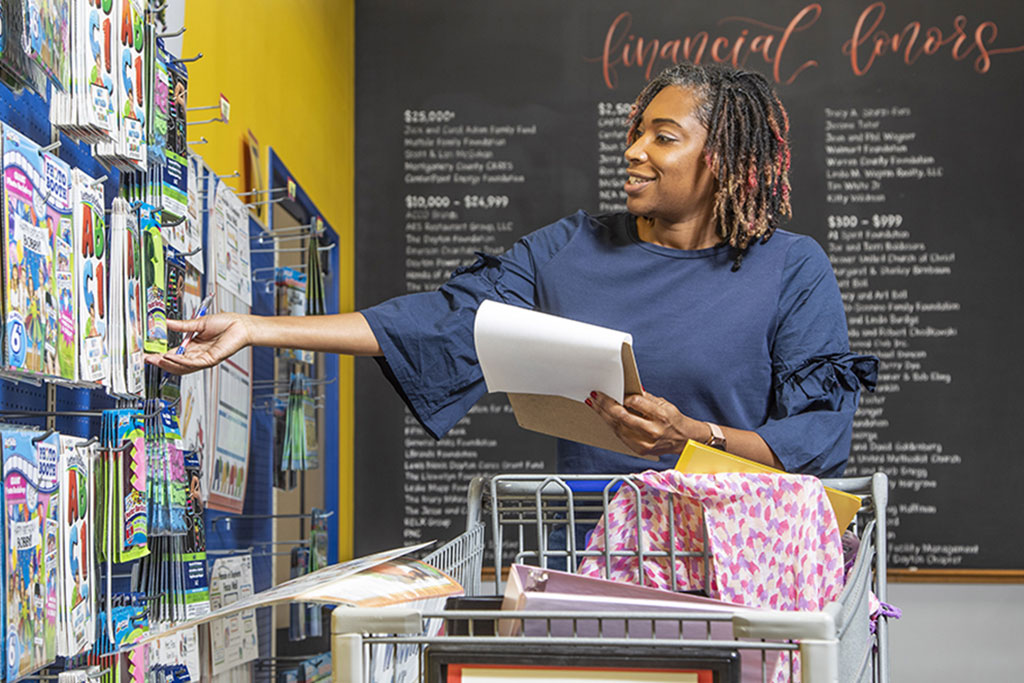
What kinds of supplies are typically needed most?
The most commonly requested supplies are basic ones that many people might take for granted—pencils, crayons, markers, and notebooks. We actually have volunteers make the latter for us, and those always fly off the shelves. Our inventory can change according to the season too. For instance, in winter, we’ll provide pieces of clothing like hats, socks, and underwear on top of our typical stock. It’s sometimes hard to keep up with demand since so many students need the items we offer.
How would you describe Crayons to Classrooms’ impact?
Since we launched in 2009, we’ve distributed $40 million in supplies. The impact is incredible, and we hear about it directly from teachers all the time. They often share stories about students who would come to school without a backpack or pencils and how being able to provide them made a huge difference.
Having access to supplies also boosts students’ confidence. Imagine being a child who doesn’t have crayons or markers for an art project while your peers do. That feeling of being left out or unprepared can be discouraging. But when a student has what they need, they engage more in their learning and feel more included in the classroom experience. And for teachers, the relief is significant since they don’t have to spend their own money on materials. It allows them to focus on teaching rather than worrying about whether they’ll have enough notebooks or tissues for their students.
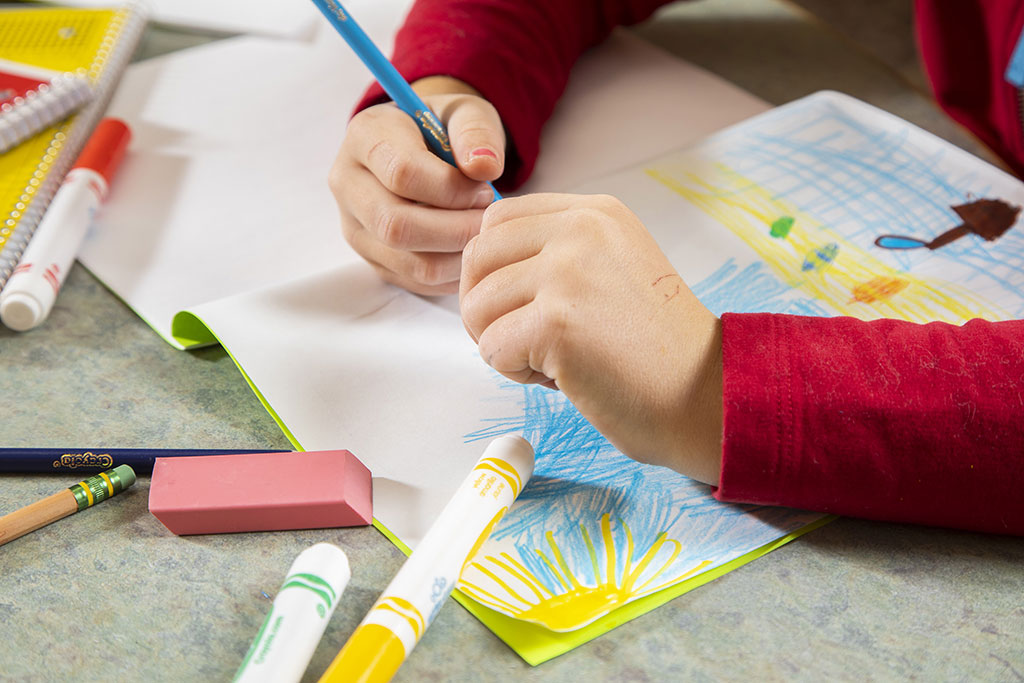
How can people support your organization?
There are several ways to get involved, and every little bit counts. Monetary donations are tremendous since they enable us to purchase items for the store. People can give one-time gifts or join our Backpack Boosters program, through which they can make a monthly contribution of their choosing—it only takes $8 a month to support a student for an entire year! We’ll also take new school supplies donated directly; we accept everything from pencils and crayons to notebooks and backpacks.
Volunteering is another great opportunity to support our mission. We rely on volunteers to organize donations, stock shelves in our store, and assist during teacher shopping days. Further, businesses and community groups can host supply drives, events that not only make a tangible impact on local classrooms but also bring people together.
For those outside our region, we have remote volunteer projects, including making ten-page notebooks for our store or sewing pocket hugs, small shapes students can use to help them concentrate during class. We’ve had people from as far away as Hawaii and Utah send in completed projects, so that’s really exciting to see.

With the school year starting soon, do you have any current initiatives?
Our big push right now is our Stuff the Bus campaign. It takes place every summer from July 1 to August 31 and allows us to collect as many supplies as possible before the school year begins. During this time, we encourage businesses, organizations, and individuals to host school-supply drives to fill our store shelves. But that’s not the only way to participate—people can also donate supplies directly or contribute financially.
To make things fun, we keep track of the number of donations that groups bring in and recognize those who contribute the most. Additionally, we have an online donation page where people can form teams and see how their contributions compare to others. Both serve to add a bit of friendly competition. All in all, this campaign is just another way for Crayons to Classrooms to help ensure that every teacher has the resources they need to create a successful learning environment.
For more info, visit crayonstoclassrooms.org
